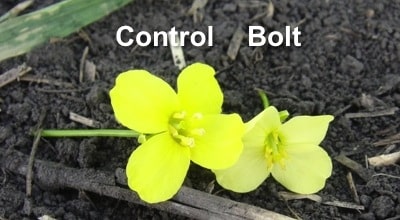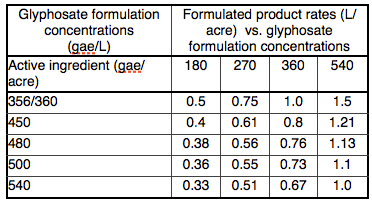
Spraying late or at higher-than-label rates can reduce canola profits. AAFC research showed an advantage of 3 bu./ac. for controlling weeds at the 1-2 leaf stage of canola versus the 3-4 leaf stage, and a 7 bu./ac. advantage when applied early versus the 6-7 leaf stage. At $12 per bushel, that early control provides $36 to $84 per acre more profit with no added cost. These numbers will be even higher if a preseed burnoff was not completed.
Late applications of glyphosate on Roundup Ready canola can add to those losses. Monsanto research demonstrated a 3 bu./ac. yield loss as a result of spraying glyphosate on their glyphosate tolerant (Roundup Ready) canola at higher than labeled rates and at first flower —beyond the 6 leaf stage on the label. The maximum rates of glyphosate that can be applied to glyphosate tolerant canola is two applications of 180 grams active (gae) per acre or a single application of 270 gae/acre. The application window is up to the 6-leaf stage.
Glyphosate may cost only $5 per litre, which is equivalent to two applications of 0.5 L/acre allowed on 356/360-gram formulations, so applying higher rates does not significantly increase cost of production — but the estimated 3% yield loss from that higher rate can greatly reduce canola profits. In fact, the loss of yield due to an off-label application can cost you as much as 4 applications of glyphosate. If weeds are bigger than the label indicates as a maximum stage, significant losses from competition have already occurred, and control by herbicides will be reduced, leading to poor or negative return on the herbicide application.
Liberty Link: The maximum rate of Liberty is 2.97 L/ac., in two applications — a maximum of 1.62 for the first application and a maximum of 1.35 for the second.
Clearfield: You can apply any one of these products only once per season: Ares, Odyssey, Odyssey DLX, Solo, Tensile, Absolute. For example, if you spray Ares, you can’t spray a second application with Ares, Odyssey or any others on that list. The window of application is 2- to 7-leaf stage of the crop for Ares and 2- to 6-leaf stage for all other Clearfield partner products. Ares, Absolute and Odyssey have soil residual components that provide some short term control of emerging shortly after the application. Exceeding these rates can result in soil residues that carry the risk of injuring following crops, even recommended re-crop options.

